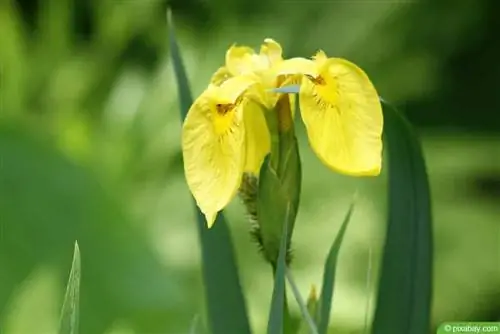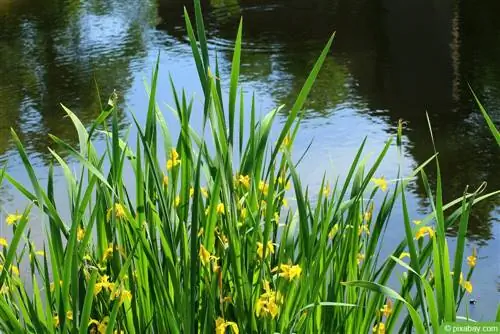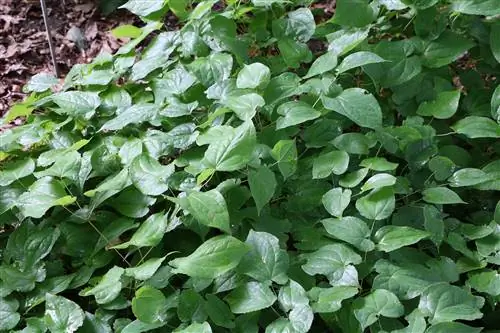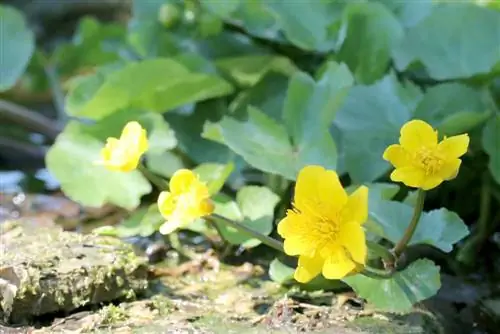- Author admin [email protected].
- Public 2023-12-17 03:39.
- Last modified 2025-01-24 12:45.
The swamp iris grows as a perennial, herbaceous plant with heights of approx. 100 cm. In addition to its sword-shaped, up to 90 cm long leaves, it is particularly impressive with its typical, rich yellow iris flowers, which it presents between May and the beginning of July. Thanks to its creeping and persistent rhizome, it forms larger populations in a short time, provided the location and care meet its requirements.
Profile
- Plant family: Iridaceae
- Botanical name: Iris pseudacorus
- German name: water iris, yellow iris, pond lily, swamp lily
- Growth: persistent, herbaceous, horizontal creeping rhizome
- Growth heights: 60-100 cm
- Flowering period: May to July
- Flower: single flower, yellow cathedral and hanging leaves, black-brown markings in the middle
- Leaf: broad sword-shaped, pointed, shedding foliage
- Lime tolerance: Lime tolerant
- Toxicity: poisonous in all parts
Location
As the name suggests, this iris feels most comfortable in the swamp or in the swamp zone of a garden pond. It should be in a sunny to partially shaded part of the garden. In this case, swamp zone means in a water depth of 10 to a maximum of 20 cm.
A place at the edge of a pond, an artificial stream or generally in garden areas with muddy or constantly moist soil is also suitable. In general, this plant copes well with changing water levels and water depths of up to 40 cm, although the flower production is then significantly lower. For a short time she is content with a drier place on the edge of the bank.
Floor
The swamp iris is a typical swamp perennial and therefore thrives best in heavy and wet clay soil. It copes better with acidic to slightly alkaline soils than with soils that are too calcareous, although it has a certain tolerance to lime. As long as the soil is permanently moist to wet and can store moisture well, it can also stand well in the garden soil. In addition, the soil should be rich in humus and nutrients.
Tip:
The respective soil should not dry out completely if possible. Dryness in spring in particular can significantly affect flower formation.
Planting
The best planting time for the pond lily (Iris pseudacorus) is in March and from August to mid-October. When planting, you can plant the rhizome horizontally just below the top layer of soil or in a planting basket beforehand. The latter has the advantage that the plants cannot spread too much because they are very vigorous.
In addition, they are easier to remove from the pond and weaker neighboring plants are protected. Regardless of the type of planting, you should count around two plants per square meter. To plant in a basket, you need a plant basket, some fleece, washed, lime-free pebbles and a special pond substrate.
- Sales pot unsuitable for permanent pond planting
- Wire mesh plant basket ideal
- Should be slightly larger than the ball or rhizome
- Introduce plants promptly after purchase
- If there is a delay, dip the swamp lily in water and store in a plastic bag
- Basket as washout protection, first line it with fleece
- Then fill in some pond soil and insert the pond lily
- Fill with soil up to 2.5 cm below the edge of the basket
- Commercial planting or potting soil too nutrient-rich
- Nutrient excess would promote algae growth
- To weigh it down, add gravel as the top layer
- Slowly place the basket into the pond at the appropriate depth
- Observe the maximum planting depth, otherwise there is a risk of rot
- Maintain planting distances of approx. 40 cm
Tip:
Correspondingly larger baskets can easily be placed in the pond with several plants. Good alternatives to pond soil are lime-free gravel and broken clay granules.
Care instructions

With the right care, the swamp iris also has a long and he althy life.
Watering and fertilizing
Once rooted, the pond lily is very undemanding and easy to care for. Specimens in the pond are usually neither watered nor fertilized. If the plant is outside a pond, on suitable soil, it is important to fertilize it regularly. By the way, swamp irises love nitrogen. It is best to give a sufficient amount of humus or mature compost in the spring, when budding begins. Watering is done so that the soil is constantly moist and does not dry out completely and permanently.
Cutting and overwintering
Normal pruning like with other plants is not possible and not necessary for the swamp lily. In most cases it is sufficient to cut old leaves from the plant in spring. They should be preserved over the winter. In autumn, all wilted and dried parts of the plant, including the fruit heads, are removed to avoid uncontrolled spread. If you need seeds for propagation, allow a few seed heads to mature on the plant. As far as frost resistance is concerned, this plant, which is predestined for the swamp or pond, is hardy down to minus 29 degrees. As a result, it gets along very well without any winter protection.
Tip:
This plant is poisonous in all parts, especially in the root area. Therefore, you should wear gloves when cutting or handling it in any way.
Propagate
There are various ways to propagate the swamp iris, you can find out how to do it here.
Sowing
One form of propagation is via seeds. These can be purchased commercially or obtained in the fall from the ripe fruit capsules of existing plants. They should be sown as soon as possible after harvesting.
- Best time to sow from October to December
- Harvest seeds as soon as the ripe fruit capsules burst
- Then soak in room temperature water for 4-5 days
- Seeds need a cold stimulus to germinate (frost germinators)
- Sow in small pots with sandy-loamy substrate or sand
- Moisten the substrate afterwards
- Put the pots in the fridge or directly outside for several weeks
- Frost effects in winter important for germination
- If necessary, cover with snow if available
- Seeds should not dry out until germination
- Germination occurs the following spring
- First seeds often germinate after about a month
As soon as the seedlings have reached a size of 3-4 centimeters, they can be separated into nutrient-rich substrate. They can initially be cultivated in a frost-free room until spring. The most important thing is to keep the substrate evenly moist. Or you can place the pots in a bowl with enough water, which you can refill occasionally. In May/June the young plants can be placed in plant baskets and then in the garden pond. It can take between three and six years for plants propagated from seed to bloom for the first time.
Tip:
Pond lilies can also reproduce very well themselves via their floating seeds and their creeping rhizome.
Division
The swamp lily is one of the most spreading swamp perennials, so division may be necessary in order not to put too much pressure on neighboring plants. Or you can simply divide them so that you can plant them in different locations. The best time for this is during the vegetation period in spring. The thick-fleshed rhizomes are divided.
- Division approximately every 3-4 years recommended
- Iris otherwise it will stop flowering at some point
- Best time, in spring
- First dig up the plant generously
- Or lift the basket out of the pond
- Remove from the basket and remove any remaining soil
- If necessary, spray with a garden hose
- Remove damaged and dead root parts
- Divide the rootstock with a spade or sharp knife
- Each section must have roots
- Use newly obtained plants separately from each other
- When planting without a basket, spacing of 40 cm is advisable
Diseases and pests

If the Iris pseudacorus is in the right location and receives sufficient moisture, there is no need to fear infestation by pests or diseases. However, the conditions are often anything but optimal, which opens the door to pests. If the plant lacks moisture, it can become problematic. It hardly grows or doesn't grow at all and the flowering could also stop altogether. The pests that can attack this iris include, in particular, the iris weevil and the iris sawfly.
Iris Weevil
The iris weevil grows up to five millimeters in size and has white dots on its back. It mainly occurs in the summer months. But the actual pests are their larvae. They drill into the buds to systematically hollow them out. If you look closely, you can see the entrance to the feeding duct as a dark brown dot. In most cases, direct control is not necessary. Normally it is enough to read the beetles.
Iris sawfly
The larvae of the iris sawfly are also the ones that leave ugly feeding marks on the leaves of the marsh iris. Depending on the severity of the infestation, they can eat these plants completely bare. There are no suitable means of combating it, although in some federal states these animals are even on the red list of endangered species. The only thing you can do is pick off the wasps and cut the eaten leaves from the plant. In ponds with fish, you can also spray the larvae with a stronger jet of water, as they are a sought-after treat for fish.
Good companions for the swamp iris
With the right companion plants, the swamp iris comes into its own even better. When choosing the right plants, you should make sure that they do not grow too tall and cast too much shade. They should not form any branches themselves so as not to restrict each other. For example, the approximately 20 cm high penny loosestrife, the 80 cm high Cyprus grass sedge and other clump-forming Carex species are suitable for the damp water or pond edge or the bank area. In addition, the purple loosestrife (Lythrum salicaria), up to 150 cm tall, and smaller marsh rush species (Eleocharis) are suitable plant neighbors.
Extraordinary abilities of this impressive plant
The swamp iris Iris pseudacorus is a so-called reposition plant. This means that, on the one hand, it is used as a holding plant to stabilize banks and, in particular, to purify water. They serve as a natural soil filter in garden, swimming and koi ponds as well as in constructed wetlands. They absorb pollutants from the water and slowly break them down again. In this way, they contribute to a nutrient balance in the garden pond. Their roots also provide a habitat for numerous small water creatures.
Tip:
Swamp irises in the wild are protected and may only be removed there with permission. This is not necessary, because garden retailers offer a variety of attractive cultivars.






